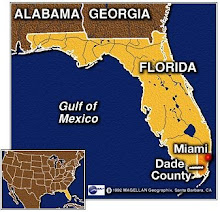Parrot Jungle used to be located in Pinecrest, part of Miami-Dade County.
During Hurricane Andrew in 1992, the park was damaged. Now there are flocks of wild parrots around Miami! I wasn't particularly aware of them until I moved a couple of miles away from my old apartment in Pinecrest. There is a flock that lives in my neighborhood, Kings Creek.
The parrots are really, really loud. Lots of squawking. Not really a beautiful sound. It used to bother me but now I don't notice the squawking, even though it travels around as they move from tree to building to tree. They travel in bunches, but then you'll see pairs off alone as well - it's sweet. Once there was a pair by at my window - one was hanging upside down on the screen, looking in at my blinds. It was noisily shuffling around on the screen. The other appeared to be keeping watch! As soon as I peeked at them, though, they looked startled and took off.
My parents were just here; my mom said it reminded her of the movie "The Wild Parrots of Telegraph Hill." We ran outside my apartment to try to see them but they kept moving! The Miami parrots don't have a full red head like that movie's parrots; ours either have red on the very tops of their heads or no red at all. Here are some pictures I found of Miami parrots - I have trouble taking decent photos myself!
Wednesday, February 4, 2009
Subscribe to:
Post Comments (Atom)




3 comments:
The parrots with the red heads appear to be red-fronted conures. And you're right, they're not the same species as in the move. The other green parrot with the big white eye patch is some kind of macaw.
Are macaws a type of parrot?
I receive all comments in my email - google decided to give me this ad when I opened this comment:
Bird Diaper FlightSuits - www.Bird-Diaper.com - Diapers, Costumes, Leashes, more Parrots, Cockatiels, Cockatoos
Hi!
I just happened upon your blog. Yes, the parrots are an interesting feature of the Miami area. In the 22 years that I've lived here, I never get bored of watching the different species that are present.
However, you know, Parrot Jungle (and Metrozoo for that matter) didn't lose any parrots due to Andrew. After the native species (Carolina Parakeet- a relative of the conures) was wiped out, other non-native species began to appear by various human introductions. Rose-ringed parakeets were noted in the Miami area by the 1930s, and disappeared by the mid 1990s. Monk and canary-winged parakeets became established here in the 1960s, and are still present- especially monk. The real increase on species occurred in the early-mid 1980s with Amazonas, and especially conures- which are the most common wild birds here today. These were part of the massive elicit parrot trade in those days from Latin America. Chestnut-fronted and blue-and yellow macaws (also still present) began to breed in the Miami area around that time.
Today, it is interesting to see how different species, especially Amazonas and conures, have 'partitioned' southeast Florida.
Happy Birding!
Frank W. Schena
Royal Palm Tours of Miami
royalpalmtoursofmiami.com
Post a Comment